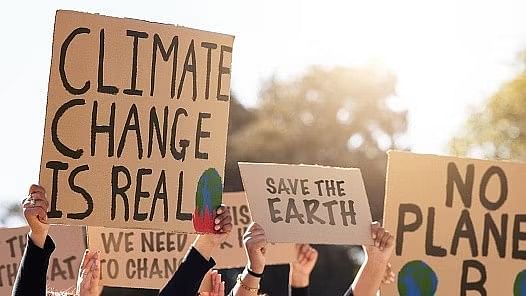
Representative image of climate change.
Credit: iStock Photo
Dubai: Heat stress. Lung damage from wildfire smoke. The spread of disease-carrying mosquitoes into new regions as temperatures rise.
These are just a few of the ways that public health has been impacted and compounded by climate change - a focus for the first time ever at the annual UN climate summit COP28.
Government ministers are expected to discuss ways they can protect people from climate-driven health threats, which now threaten to undo decades of progress in public health.
From 2030, experts expect that just four of these threats - malnutrition, malaria, diarrhoea and heat stress - will push global death tolls up by 250,000 per year, according to the World Health Organization (WHO).
"Extreme weather events are becoming extreme health events," said Martin Edlund, CEO of global health nonprofit Malaria No More.
Here's how climate change is harming people's health across the world today, and what countries might expect in the future.
VECTOR-BORNE DISEASES
Mosquitoes that carry viruses including dengue, malaria, West Nile and Zika are shifting into new parts of the world as warmer temperatures and heavy rains create more hospitable conditions for them to breed.
Reported dengue cases have grown from around half a million in 2000 to more than 5 million in 2019, according to the WHO.
Just this year, cases in Brazil are up 73 per cent against the five-year average, said Edlund, with Bangladesh suffering a record dengue outbreak.
Climate change is also having an unpredictable impact on malaria, with 5 million more cases registered in 2022 than the previous year - reaching a total of 249 million, the WHO's World Malaria Report found.
Floods in Pakistan last year, for example, led to a 400 per cent increase in malaria cases in the country, the report said.
The disease has also spread into the highlands of Africa that previously had been cold for mosquitoes.
Two new malaria vaccines expected to be available next year offer some hope of combating the scourge.
MURKY WATERS
Storms and flooding wrought by climate change are allowing other infectious water-borne diseases to proliferate as well.
After decades of progress against cholera, an intestinal infection spread by contaminated food and water, case numbers are rising again, including in countries that had all but extirpated the disease.
Without treatment, cholera can kill within hours.
In 2022, 44 countries reported cholera cases, a 25 per cent increase over 2021, according to the WHO, which noted the role played by cyclones, floods, and drought in cutting off access to clean water and helping bacteria to thrive.
Recent outbreaks have also been far deadlier, with fatality rates now at the highest recorded level in over a decade, the WHO said.
Diarrhoea, too, receives a boost from climate change, with increasingly erratic rainfall - resulting in either wet or dry conditions - yielding a higher risk, research has found.
Diarrhoea is the world's second leading cause of death among children under 5, after pneumonia, claiming the lives of more than half a million kids every year.
EXTREME HEAT AND SMOKY SKIES
Heat stress - one of the more obvious health impacts of global warming - is projected to impact hundreds of millions of people as temperatures continue to climb through the next few decades.
With the world already about 1.1C (2F) warmer than the average preindustrial temperature, people in 2022 experienced about 86 days on average of dangerously high temperatures, a report from the Lancet medical journal found last month.
If the world warms by 2C above preindustrial levels, the report said, yearly heat deaths could more than quadruple.
A July study in the journal Nature Medicine estimated that some 61,000 people died during European heatwaves in the summer of 2022.
The heat has also made forests drier, fuelling extreme wildfires that have swept across large swathes of the world in recent years.
During the decade starting in 2010, more than 2 billion people were exposed to at least one day per year of unhealthy air pollution from fire smoke, according to a September study in the journal Nature. That was up by 6.8 per cent compared with the previous decade.
In the United States, wildfire air pollution now kills somewhere between 4,000 and 28,000 people annually, according to the American Thoracic Society.
For daily comprehensive coverage on COP28 in your inbox, sign up for the Reuters Sustainable Switch newsletter here.